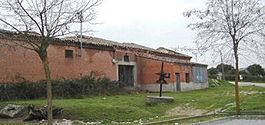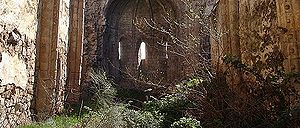Compañeros - Bonus Page: Difference between revisions
No edit summary |
No edit summary |
||
| Line 1: | Line 1: | ||
=='''THIS PAGE IS UNDER CONSTRUCTION'''== | =='''THIS PAGE IS UNDER CONSTRUCTION'''== | ||
[[File: | [[File:Companeros BonusPage3.png|right|500px]] | ||
Revision as of 19:09, 4 March 2012
THIS PAGE IS UNDER CONSTRUCTION
Compañeros and the Mexican Revolution
The story begins with a scene set on the eve of the presidential elections of 1910. At an improvised registration office people are asked if they are going to vote for Porfirio Diaz or for another candadate. Those who plan to vote against Diaz, are shot on the spot. Diaz was a former general and war-hero (he had fought against the French), who was president of Mexico from 1876 to 1911, with the exception of a four-year term served by his political ally Manuel Gonzalez from 1880 to 1884. His presidency was marked by economical growth, but also by repression and political stagnation. He changed the constitution twice, so he could be elected president for life. Diaz favoured foreign investments but also encouraged the so-called peonage, a system which left laborers virtually without any rights; many historians have called it legal slavery. The situation led to a growing gap between rich and poor, which was one of the immediate causes of the Mexican Revolution.
To ensure his own re-election in 1910, Diaz had thrown his opponent Francisco Madero in jail. However, Madero escaped and fled to San Antonio, Texas in the US. The character of Professor Xanthos, seems partly modeled after Madero (Xanthos is held prisoner in Yuma), but note that Madero was no pacifist. Like Alex Cox has noted, it’s very unlikely that there was any politician or political agitator with pacifist ideas at this time in Mexico). The real-life Madero issued a “letter from jail” in which he declared Diaz’ regime illegal and called for a revolt against Diaz. Madero was supported by, among others, Emilio Zapata and Pancho Villa, and managed to overthrow Diaz, but was overthrown (and killed) himself two years later by the treacherous general Huerta.
Corbucci and Politics
Films are as much about the time in which they are made, as about the time in which they are set. Professor Xanthos and his students sound like European intellectuals from the sixties, not like Mexicans from the beginning of the Twentieth Century. The Zapata westerns were made within a post-WWII context, by left-wing film makers who were at variance with the authorities. The communist partisans had fought side by side with other Italians against Mussolini and his black coats, but after the war they were left out of the government by Christian-democratic leader Di Gaspari. Moreover De Gaspari embarked on a strong pro-American (and anti-communist) course. Many left-wing intellectuals experienced this as betrayal. Corbucci was one of them.
According to Corbucci, all his westerns of the second half of the sixties were ‘political’. Unlike Franco Solinas, the most prolific Italian left-wing screenwriter of the sixties, Corbucci wasn’t a political analyst. His sympathy for the poor, was prompted by his conviction that justice as defined by the state, did not apply to those who were discriminated or literally rejected by society. In The Great Silence those citizens without rights were the outlaws (chased by hired killers), in his Zapatas the peons.
The screenplays of Corbucci’s Zapatas offer a variation on the master-pupil device, often used within the western genre. In Corbucci’s variety, the relationship has become dialectical: the master teaches the pupil (in this case in the art of warfare), but is at the same time instructed by him (he learns to understand the pupil’s situation and cause); the teacher is, in other words, at the same time a pupil, the pupil at the same time a teacher. The strong female serves as a catalyst in this process, representing compassion and fertility (both of the revolution and the land). The character of the peon was so attractive to Italian film makers, because they could be used as a symbol of the Third World. Symbolically, Corbucci’s Zapatas are parables in which the Old World (the European professional) unites with the Third World (the peon) against the New World (international capitalism).
Existentialism
Existentialism is a philosophical and cultural movement, which became very popular in post-World War II years. The movement was foreshadowed by illustrious names like Kierkegaard, Nietzsche and Heidegger, but it was French philosopher Jean-Paul Sartre who made it fashionable. He also turned it into a left-wing, atheist philosophy. Sartre’s works were discussed in left-wing circles, and it’s clear that Corbucci was familiar with his doctrine. The central idea of post-War existentialism is that “existence precedes essence”. It means that man is only defined by his own acts, there is no pre-conceived ‘essence’: a person is thrown into this world and can choose to be good or bad, he is neither of the two things essentially; his acts, the choices he makes, will eventually determine what kind of person he is, a good one or a bad one. But as a result of this human condition, man is destined to choose (his liberty forces him to take a stance): only by making an active choice, he is able to determine himself (otherwise others will determine him). Both El Vasco and Yodlaf Peterson are existentialist characters: they act in order to be. They have adapted to history so far, but now they will try to change it. To some extent professor Xanthos and Lola can be seen as existentialist characters too. Xanthos has never resisted the evil forces (and that’s what Corbucci blamed pacifists in general), but he takes up an arm (albeit one that isn’t charged) in the end. Lola (and her fellow students) shoot the renegade general Mongo to pieces when he’s about to kill the professor. Sartre would say that in this very moment they act, and therefore are.
Locations
Compañeros was shot on various locations in Central and Southern Spain. Additional scenes were shot on the premises of the Cinécittà studios.
The white village is the Andalusian village of El Argamason, North-East of Almeria. Many outdour scenes filmed North of Almeria, in the region Balsicas de Alfara, very popular among spaghetti westen directors. The opening and closing moments, with the duel at the train station and Yodlaf screaming “Vamos a matar, compañeros!” were filmed near the town of Villamanta, West of Madrid. In this region several other scenes were filmed. The Rio Alberche was used to represent the Rio Grande and the American-Mexican border region. The scenes with Yodlaf, El Vasco and Xanthos overlooking the Rio Grande from a plateau, were filmed near the power plant of Embalse de las Picadas in a widening of the Rio Alberche. The scenes in which the Xanthisthas receive a delegation from General mongo and meet with Yodlaf and El Vasco, were shot near Pelayos de la Presa, in the ruins of a monastery, called Santa Maria La Real de Valdeiglesias.






Different Versions & DVD Info
In most countries the film was released with a running time of 114 minutes. The parts that were cut, were never dubbed in English, so in the uncut version, they are in Italian with English subtitles. Both the R2 DVD released by Starlight Film and the R1 DVD from Blue Underground (previously released by Anchor Bay) are said to be uncut. They run a little over 120 minutes. The Starlight Film DVD is a pretentious release, with 3 versions on 2 DVDs. Unless you're interested in a horribly looking Super 8 version or the cut theatrical release (which has only German audio) only the uncut version is of real interest. It runs 120 minutes, is presented in the original ratio of 2,35:1 and has been anamorphically enhanced for widescreen TVs. There are two language tracks, German and English. At first sight this is an excellent print, but soon its limitations become clear. Colours are strong but the image is remarkably soft for an anamorphic transfer and gets even a bit smudgy during fast camera movements. The Blue Underground disc has far better image quality and also has the original Italian audio track. The anamorphic image is sharp and colours are warm. Both discs have interesting extras; best of all are the interviews, with Morricone analyzing his score, Milian bragging about his own thespian talents (he seems to have inventend method acting too) and Nero making some interesting (and very funny) remarks about the accents used in westerns, and getting tears in his eyes when he talks about the deceased Corbucci. The French release by Seven 7, released in 2011 has excellent image quality, but has a running time of no more than 99 (!) minutes, and only French audio.
--By Scherpschutter




